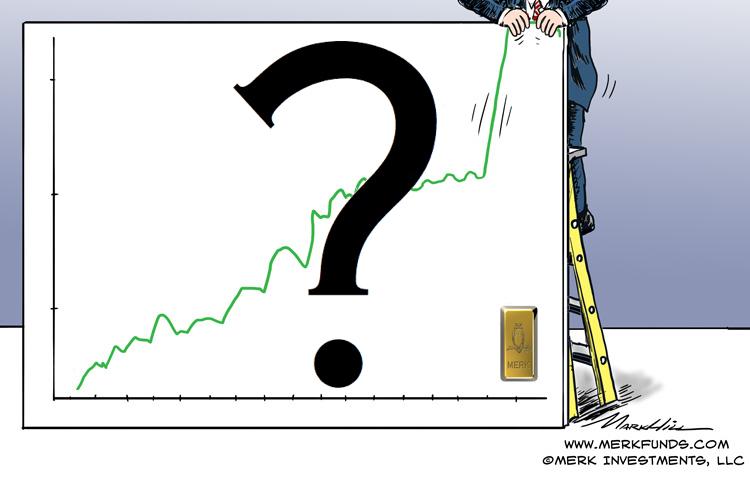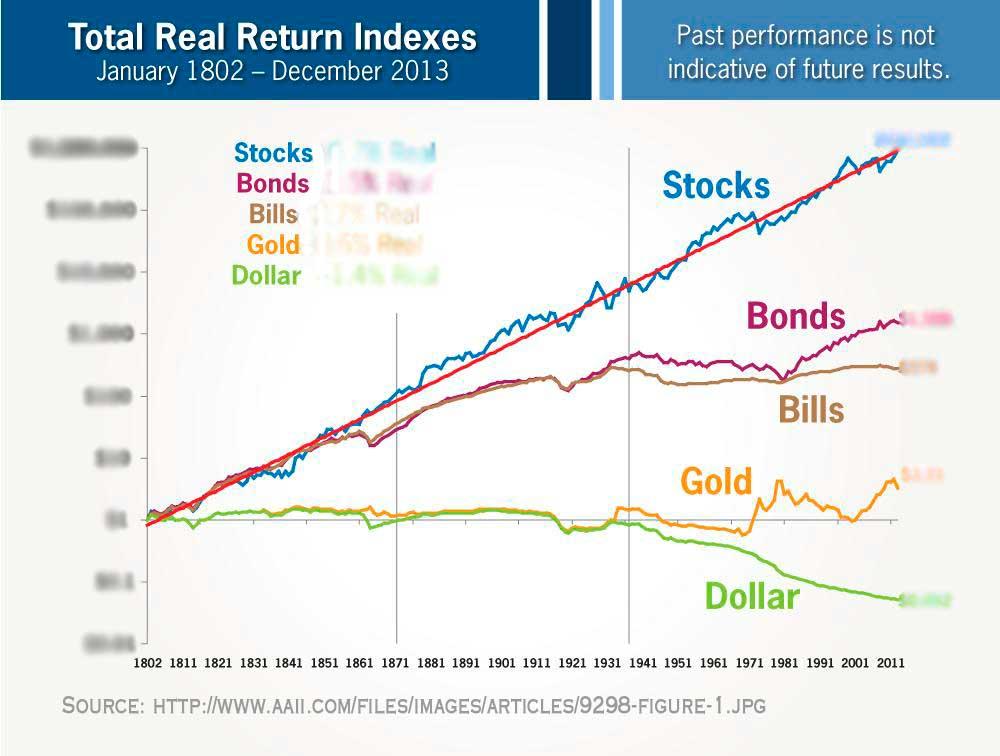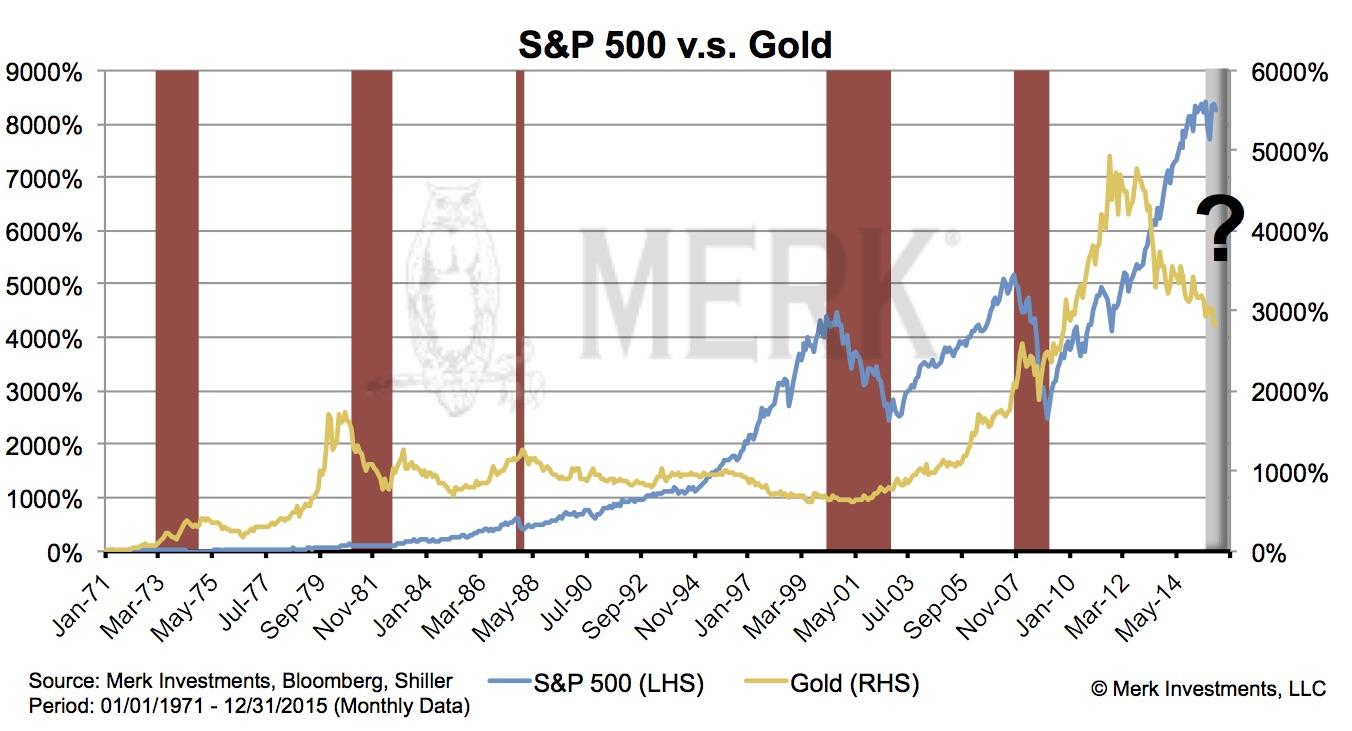
As background, Wharton School Professor Jeremy Siegel is author of the book Stocks for the Long Run, first published in 1994. I have heard Siegel, who is also the public face of a major ETF sponsor, frequently present the bullish case for stocks. Siegel had yet another bull-speech at a recent conference, in a follow-up discussion on gold that was on the outperformance of stocks versus gold. According to Siegel’s work, stocks returned a real rate of return of 6.7% from 1802 to 2013; in comparison, gold had a real rate of return of 0.6%. This provides the appearance that stocks beat gold hands down; assuming this is correct, why would this misguide investors? First, let’s clarify that these numbers are said to be real rates of return, not nominal rates (real rates of return are after inflation). Here is a publicly accessible chart of Siegel's theme; note that I intentionally obfuscated the specific numbers as I have concerns with the methodology used that go beyond the scope of this analysis:

Gold as a diversifier?
Keep in mind that gold is a brick, albeit a shiny one. It's not meant to outperform stocks in the long run; the reason we use bonds and cash is not because we think they'll outperform stocks in the long run, but because they may be valuable diversifiers.The chart shows the dollar started to underperform after the Fed was introduced in the early part of last century, then in earnest during the Great Depression. We also read into this chart that the credit driven super cycle that started at the end of the Great Depression was at the expense of the dollar.
The dollar was linked to gold for most of the period that chart shows. The link persisted until 1971; the outperformance of gold versus cash prior to 1971 is attributed to official debasements of the dollar. Let’s have a closer look at the performance of bonds from the end of the Great Depression until Paul Volcker became Chairman of the Fed (that was in August 1979). That negative performance has a good reason: we experienced an environment of financial repression as real interest rates were negative. It’s that sort of environment that we believe is favorable to gold as receiving no interest is better than negative real rates. However, gold couldn’t react at the time, because of the link between the dollar and gold. The 'gold window' closed because the U.S. could no longer sustain the link; not surprisingly, the period after 1971 was rather volatile and distortions (the boom/bust of 1980) were a side effect.
We believe that similar to the Great Depression, we are near the end of a debt super cycle. That means, after decades of credit expansion, it’s time to reduce the relative debt in the economy; the ways to achieve this are through growth, default or inflation; hedge fund manager Ray Dalio has been very outspoken on this of late. If our analysis is correct, then odds are high that the era of financial repression may well persist for some time, as the huge debt overhang is worked through. In that context, gold, these days no longer pegged to the dollar, may perform favorably compared to bonds and the dollar. As such, gold may be a good diversifier to a stock portfolio, in the right circumstances.
It’s in this context that I perceive Jeremy Siegel’s touting of stocks may be doing a disservice to investors. Very few advisers recommend a 100% stock allocation; the reason we diversify our portfolios is because most of us are looking to maximize risk-adjusted returns. Diversification is the one free lunch that Wall Street offers. This doesn’t mean gold, or any one specific asset is the ideal diversifier; but it strongly suggests that touting gold or any asset class as the single best investment may be problematic, unless accompanied by a litany of disclaimers/qualifiers.
Gold to outperform?
If stocks have done so well over 200 years compared to gold, is it possible for gold to outperform stocks over a shorter horizon, say 2 years, 10 years or 20 years? The challenge with historical comparisons is that one can always cherry pick to choose what suits one’s argument. One can choose the price of gold at the peak of 1980 to see how long it has languished; or one can pick the top of the Nasdaq bubble, just as gold bottomed out a few years later to see how gold might do versus stocks for many years. Ultimately, what matters to investors is what the price of gold is going to do going forward. We like to show the price of gold since 1971 (when it de-coupled from the U.S. dollar) in relation to past bear markets in equities. During this period from 1970 through 2015, gold had an annual return of 7.70% with a correlation to equities of zero:
One notable exception is the bear market that accompanied Volcker’s interest rate hikes in the early 1980s. As I have indicated in the past, anyone who expects a similar monetary policy, should not expect gold to perform well. However, we take the Fed at its word that even as inflation and employment moves back to what historically was considered normal, rates may continue to be lower than normal (as the last paragraph of the FOMC statement has stated this since the spring of 2014). To me, that’s a commitment to be ‘behind the curve’, i.e. that rates will be rising slower than inflation. In fact, Fed Vice Chair Stan Fischer in a speech on Monday, February 1, 2016, said that he wouldn’t mind for inflation to temporarily overshoot on the upside. All of this suggests that real interest rates may continue to be low, possibly even negative. While there is no assurance gold will do well in such an environment, to me, it is a key long-term driver for the price of gold.
If I look out 10 years and consider the projections of U.S. deficits, I have a hard time seeing how we can afford positive real interest rates. This may bode well for the price of gold. But will gold outperform stocks? I happen to be very negative on stocks in the current environment. Last August, before the sharp selloff in equities, I published a newsletter Coming Out - As a Bear!; the basic premise of the analysis is that the Fed had “compressed risk premia,†i.e. bid up asset prices and taken fear out of the market. For years, investors piled into risky assets, such as equities, not appreciative of their inherent risks. As part of that process, they are likely now over-exposed to equities, having ‘bought the dips’ rather than prudently diversifying. It seems the mentality is gradually shifting towards capital preservation, i.e. ‘selling the rallies,’ but this is a process that, in my assessment, will “at a minimum“ take months.
As such, I see the current environment much more like 2000 where investors seemed to be in denial for a long time as equities cascaded lower. This time around, we may have a more aggressive Bank of Japan and European Central Bank; I might change my mind, but so far, I don’t see them being strong enough to stem against the tide. At some point the Fed may join the easing camp once again, but I believe they will be late as they are too focused on the labor market that’s generally considered a lagging indicator. Think of the Fed having removed the lid from a pressure cooker; so even if or when the Fed turns to easing once again, it might have a difficult time preventing this bear market from unfolding. Stay tuned as we update our view.
In the above outlined environment, gold may perform quite well. Can I make a prediction that gold will outperform stocks for 10 or even 20 years? No, because too many things can change. However, I state in the article above that I started shorting equities last August; I increased my short position last December. I also own a substantial position in gold, much higher than the small diversification amount advocated by some.
I’m not suggesting that everyone should go short equities; such a strategy is fraught with many risks. But I believe there may well be times when gold can outperform. My risk tolerance allows me to put my money where my mouth is; any investor, though, should carefully evaluate how much money they allocate to gold, as the price of gold can be rather volatile measured in U.S. dollars. That, by the way, applies to stocks too.
The Merk Hard Currency Fund is a no-load mutual fund that invests in a basket of hard currencies from countries with strong monetary policies assembled to protect against the depreciation of the U.S. dollar relative to other currencies. The Fund may serve as a valuable diversification component as it seeks to protect against a decline in the dollar while potentially mitigating stock market, credit and interest riskswith the ease of investing in a mutual fund. The Fund may be appropriate for you if you are pursuing a long-term goal with a hard currency component to your portfolio; are willing to tolerate the risks associated with investments in foreign currencies; or are looking for a way to potentially mitigate downside risk in or profit from a secular bear market. For more information on the Fund and to download a prospectus, please visit www.merkfund.com. Investors should consider the investment objectives, risks and charges and expenses of the Merk Hard Currency Fund carefully before investing. This and other information is in the prospectus, a copy of which may be obtained by visiting the Fund's website at www.merkfund.com or calling 866-MERK FUND. Please read the prospectus carefully before you invest. The Fund primarily invests in foreign currencies and as such, changes in currency exchange rates will affect the value of what the Fund owns and the price of the Funds shares. Investing in foreign instruments bears a greater risk than investing in domestic instruments for reasons such as volatility of currency exchange rates and, in some cases, limited geographic focus, political and economic instability, and relatively illiquid markets. The Fund is subject to interest rate risk which is the risk that debt securities in the Funds portfolio will decline in value because of increases in market interest rates. As a non-diversified fund, the Fund will be subject to more investment risk and potential for volatility than a diversified fund because its portfolio may, at times, focus on a limited number of issuers. The Fund may also invest in derivative securities which can be volatile and involve various types and degrees of risk. For a more complete discussion of these and other Fund risks please refer to the Funds prospectus. The views in this article were those of Axel Merk as of the newsletter's publication date and may not reflect his views at any time thereafter. These views and opinions should not be construed as investment advice nor considered as an offer to sell or a solicitation of an offer to buy shares of any securities mentioned herein. Mr. Merk is the founder and president of Merk Investments LLC and is the portfolio manager for the Merk Hard Currency Fund. Foreside Fund Services, LLC, distributor.
Recommended Content
Editors’ Picks
AUD/USD remained bid above 0.6500

AUD/USD extended further its bullish performance, advancing for the fourth session in a row on Thursday, although a sustainable breakout of the key 200-day SMA at 0.6526 still remain elusive.
EUR/USD faces a minor resistance near at 1.0750

EUR/USD quickly left behind Wednesday’s small downtick and resumed its uptrend north of 1.0700 the figure, always on the back of the persistent sell-off in the US Dollar ahead of key PCE data on Friday.
Gold holds around $2,330 after dismal US data

Gold fell below $2,320 in the early American session as US yields shot higher after the data showed a significant increase in the US GDP price deflator in Q1. With safe-haven flows dominating the markets, however, XAU/USD reversed its direction and rose above $2,340.
Bitcoin price continues to get rejected from $65K resistance as SEC delays decision on spot BTC ETF options

Bitcoin (BTC) price has markets in disarray, provoking a broader market crash as it slumped to the $62,000 range on Thursday. Meanwhile, reverberations from spot BTC exchange-traded funds (ETFs) continue to influence the market.
US economy: slower growth with stronger inflation

The dollar strengthened, and stocks fell after statistical data from the US. The focus was on the preliminary estimate of GDP for the first quarter. Annualised quarterly growth came in at just 1.6%, down from the 2.5% and 3.4% previously forecast.